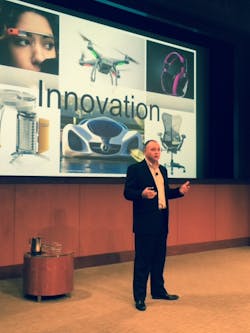We often discuss the impact of the Millennial generation on manufacturing in terms of skillsets and workforce development. But this group will also play a significant role in shaping the future of manufacturing based on their buying patterns. Customer demands are changing dramatically from the Baby Boomers—who were brand loyal and cost-conscious—to the Millennials, who want meaningful personalized products that are made in a sustainable, environmentally conscious way.
This topic was talked about this week at the Autodesk Accelerate 2015 PLM conference in Boston, along with how the cloud, Big Data, 3D printing, new types of materials and the Industrial Internet of Things (IIoT) will radically change the way things are made in the future. And if the manufacturing processes change, so must the management of the product lifecycle from design to engineering to manufacturing to distribution, and ultimately into the hands of the consumer.
Product lifecycle Management (PLM) is an important tool in this evolving closed-loop set up from product design to customer care. PLM does things like track and add context to bill of materials, manage engineering change requests (ECR) and engineering change orders (ECO), links to quality management systems, as well as to ERP systems for product cost management. And, the Autodesk PLM 360 software, which is cloud-based, enables tracking of the product details across the enterprise, as well as through a global supply chain. All of the workflows are automated so that when it is time for an individual to complete a task, the information is automatically routed. It also resides—with the most up to date information—in the PLM portal.
The workflows are what users attending the Accelerate conference valued the most. As manufacturers, they automate assembly and packaging lines, so it makes sense to automate task and process management, too.
For example, before using PLM 360, TaylorMade Golf Company’s accessories division relied on e-mail and Excel spreadsheets to connect line managers, developers, buyers, planners and vendors. Dealing with vendors around the world using this model meant possibly losing a day of productivity awaiting a response to an email that may have been lost in someone’s inbox.
“We spent way too much time on the process and not on building the product itself,” said Shawn Koutahi, global product line manager in TaylorMade’s accessories group. Koutahi admitted that this small division of the major manufacturer “ran its business in almost the same way the deli down the street runs their sandwich shop,” he said. “We lacked the essential source of product information and the information flow that the more sophisticated parts of the [TaylorMade] business had.”
Before PLM, there may have been five different owners of information and multiple documents floating around in a variety of places. Now, product data and even images of the product and materials are in a unified repository. “We created a visual delivery system where we can see the product, the cost of the product, the vendor and the lead time,” said Gabi Rojas, global business manager for the TaylorMade accessories division. “All the information we need is in one spot.”
By having easy access to product details, the TaylorMade group is building a foundation for the future. It’s a future that relies on a connected world.
“Most companies view the product development process as linear,” said Scott Reese, vice president of Autodesk’s cloud platforms division. “They have the idea that you test it, manufacture it, sell it, and retire it. But we see the future of making things as more of a cyclical process that is continually evolving and includes the customer in a more collaborative way.”
The customer experience and connected services element that the Internet of Things and the cloud can facilitate is a massive revenue opportunity for manufacturers, Reese said. Which is why Autodesk recently announced its intent to acquire SeeControl, a San Francisco-based developer of an enterprise IoT cloud service platform that helps manufacturers connect, analyze, control, and manage remote products, things and assets.
Autodesk plans to develop a new IoT system based on the SeeControl technology that will allow companies to gain real world insights of how their products perform, enabling customers to explore innovative new service models.
“A new future of making things is emerging, where any built object, product or environment can be embedded with sensors that can feed information back into the design process,” said Amar Hanspal, Autodesk’s senior vice president for information modeling. “The acquisition of SeeControl is the first step in Autodesk’s ongoing efforts to develop new technologies and solutions that will help our customers leverage the Internet of Things, starting by enabling them to capture, analyze, and utilize data from their products.”
This new model of managing product data will also spur innovation. Engineers spend a lot of time going back to the drawing board, but 80% of what is done has already been done before—they just can’t find it. PLM makes everything searchable, accessible, and visual.
“Our mission to stop designing things that already exist,” said Reese, “Stop designing the designed,” and start innovating the products.
Leaders relevant to this article:

